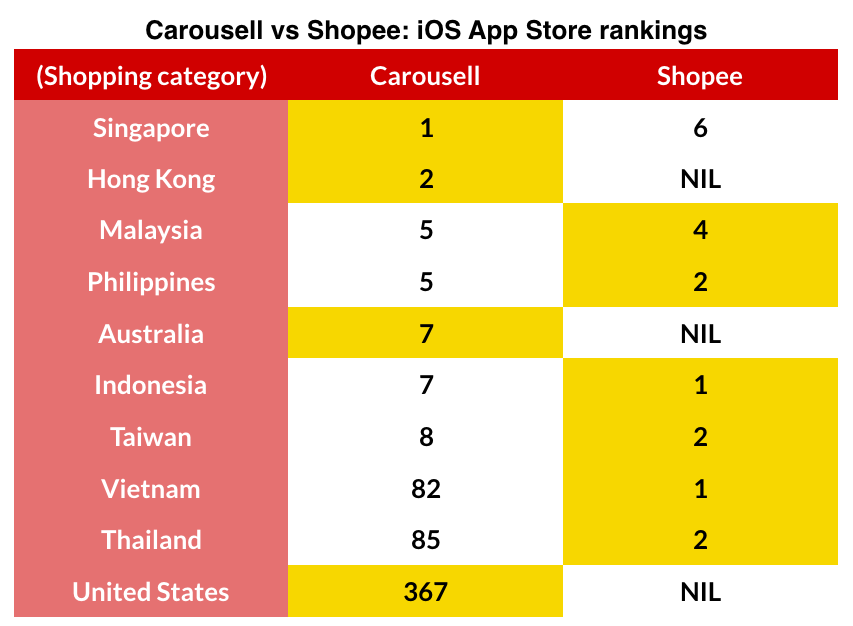
Photo credit: spotpoint74 / 123RF Stock Photo
Carousell and Shopee are locked in a fierce landgrab to become Asia’s dominant mobile marketplace. While Carousell got off to an early lead, it appears Garena-backed Shopee has caught up, and then some.
I’ll let the data do the talking. Here’s a comparison of the latest app store rankings in the shopping category on both iOS and Android, compiled from App Annie:


App store ranking is a good gauge of how an app is performing right now, incorporating factors like download and install counts, uninstalls, app usage, growth trends, and more.
The picture looks rosy for Shopee. It has soared ahead of Carousell in the Philippines, Malaysia, Taiwan, and Indonesia. These are countries that Carousell lists on its website as key markets.
Shopee’s also ahead in Thailand and Vietnam, while Carousell has maintained its lead in its Singapore stronghold and is unlikely to be dislodged from the top spot, at least in the near-term.
Carousell’s also ranking well in Hong Kong and Australia, while it’s barely noticeable in the US. Shopee does not appear to have a presence in these countries.
Shopee’s rise has been meteoric. It launched only in 2015, about three years after Carousell. It has caught up in product listings, claiming to have 65 million products on its apps compared to Carousell’s 57 million.
Shopee claims to have reached US$1.8 billion in annualized gross merchandise value. If the actual figure held up, it’ll be comparable to or even exceed Lazada.
Shopee’s vast resources from Tencent-backed Garena helped, as did its payments and logistics integrations, which Carousell lacks.
However, surface numbers may be deceiving. User acquisition costs matter. A Carousell investor, who declined to be named, questions how much of Shopee’s growth is organic.
“My understanding is that Shopee has an incredibly large spend on acquisition, discounts, and subsidies to get that number. Carousell operates on a much more lightweight and organic way comparatively. Each has its strengths, but Shopee-Garena-Tencent definitely has much, much more cash to burn so they can play that game,” he says.
Carousell CEO Quek Siu Rui, meanwhile, doesn’t see app store rankings as the most important benchmark. “We prefer to look at how successful we are in helping individuals sell their items.”
Shopee has yet to respond to Tech in Asia’s queries.
Carousell doesn’t do impulse buys
It’s in this context that we explain Carousell’s recent developments. Just today, it acquired another competitor, Duriana – a move that actually seems inorganic, to use the argument by the Carousell investor. The terms were undisclosed.
Duriana claims to have over 200,000 monthly active users, though it’s ranking poorly on Google Play’s shopping category in both the Philippines (173rd) and Malaysia (155th).
Nonetheless, the buyout is aimed at propping up Carousell in both countries, where it’s apparently lagging behind Shopee.
Then there’s Carousell’s acquisition of car classifieds site Caarly, which was announced along with a couple of key hires – PropertyGuru veteran Winnie Khoo and former Komli Media CFO Rakesh Malani. PropertyGuru is a real estate classifieds site, while Komli is an adtech firm.
All of this strongly hints at how Carousell plans to make money: by being a Craigslist on mobile. Rakesh said so himself: “When you have such an engaged user base, there are many [ways to monetize]. Premium listings is one of the easiest ones. Some users might want the convenience of having a listing appear higher or more prominently.”
It’s here that Carousell diverges from Shopee. It seems to be gunning for a pure classifieds business model, while Shopee is more of an end-to-end ecommerce marketplace.
Catch ‘em all
The future of Carousell still seems optimistic.
Unlike, say, social networking, I believe there is room for a few major players in the classifieds space, especially in a region as diverse as Asia. Look at PropertyGuru, which competes head-to-head with iProperty for dominance in Southeast Asia. Both are leaders in different countries, and both are viable businesses.
Perhaps a strategy for Carousell would be to rapidly expand to markets and verticals where Shopee does not have a presence in. Its highly-scalable classifieds approach is well-suited to this, explains the Carousell investor.
“This allows Carousell to get much easier into categories like cars and make them a lot more C2C-driven, with much stronger network effect. Shopee looks much more like an ecommerce player that takes payment and takes a percentage of transactions. They are much more merchant-driven – this makes them much more competitive to ecommerce guys like Lazada-Alibaba, Amazon, and Matahari. It’s a very expensive war to fight,” he says.
Carousell might want to fall into the arms of a well-financed backer.
However, it’s unclear how Shopee plans to monetize. While it has said in November 2015 that it plans to make money via advertising, as Taobao does, a lot can change between then and now.
So what’s the end-game for Carousell? It won’t be a stretch to say that Carousell could fall into the Catcha Group orbit (iProperty was started by Catcha), for example. After all, Catcha is practically the pioneer of classifieds in Southeast Asia, and is now even making an advertising play in frontier markets like Myanmar.
Given that Carousell’s up against a hungry Chinese giant in Tencent, now doubling down on Southeast Asia, Carousell might want to fall into the arms of a well-financed parent.
This analysis contains the opinions of the author.
This post Shopee may have overtaken Carousell as Southeast Asia’s top mobile shopping app appeared first on Tech in Asia.
from Tech in Asia https://www.techinasia.com/carousell-shopee-fight-fight-fight
via IFTTT
No comments:
Post a Comment